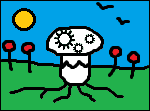Team:Wageningen UR/Notebook/Proj2/June
From 2011.igem.org
June - Fungal Track 'n Trace
3 june
Fusion PCR was initiated.
6 june
The samples from the PCR are run on an agarose gel.
Protoplast production, Hugo de Vries:
Grew Aspergillus nidulans American strain overnight in two 1-liter Erlenmeyers, each filled with 250ml transformation medium. Settings: 250 rpm, 30˚C & 250 rpm, 37 ˚C. Inoculated both with 1*106 spores/mL. Update next day: Did not grow, because no supplements were added. Without them, the strain will not grow at all.
7 june
Grew American strain on transformation medium overnight. Inoculated again with 1*106 spores/mL. This time I tried to eliminate pellet formation by adding talc powder. -250 mL at 30˚C, with talc powder -250 mL at 30˚C, without talc powder -250 mL at 37˚C, with talc powder -250 mL at 37˚C, without talc powder
8 june
Youri van Nuland helped me recovering protoplasts from the grown mycelium using the standard protocol (32). The mycelium grown from the 30˚C without talc powder was used, cause this one showed to have the best mycelium. (decent growth and least amount of pellets). This resulted in 5 mL protoplast solution (1*108 protoplasts/mL), which is good for 25 transformations. (Aliquoted 200 µL solution in each Eppendorf)
9 june
Did a transformation on the protoplasts, to see whether they are transformable. Did a co-transformation accompanied with a negative and a positive control using standard transformation protocol. Youri had some plasmid stocks available that were used for this purpose. For the positive control a Pyr plasmid was used. Update after four days: No transformants grew, not even the positive control worked. Though, some Aspergillus niger colonies grew on the plates, which indicates contamination.
14 june
Re-did co-transformation of protoplasts. Next to this, a second test was carried out to check the amount of viable protoplasts in the protoplast solutions and to check for mycelia contamination. Update after three days: No transformants grew. The second test did however show good results.
20 june
Inoculated 350 ml of transformation medium in two 2-liter Erlenmeyers with 0.5*106 spores/mL and grew them overnight at 30˚C.
21 june
Tubular shaped mycelial clumps were visible in both cultures. Recovered protoplasts together with Martijn Wapenaar. This resulted in 100 aliquots.
23 june
In the morning, 3 MM plates and 3 MMS plates were treated with all supplements needed for our strain to grow (Parabenzoic acid, Riboflavine-5p & Uridine) and inoculated with either 10, 100 or 1000 protoplasts. This test was carried out to check the amount of viable protoplasts in the protoplast aliquots and to check for mycelia contamination. In the afternoon, a co-transformation was carried out accompanied with a negative and a positive control using standard protocol. Update after four days: No protoplasts grew in both tests, only slight mycelial growth observed.
28 june
Inoculated 250 ml of transformation medium in a 1-liter Erlenmeyer with 1*106 spores/mL and grew overnight at 30˚C.
29 june
This time, no pellets were observed in the grown medium. Protoplasts were recovered. This however resulted in a very low amount of 2 aliquots.
 "
"
